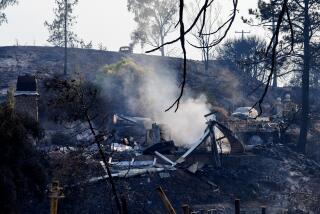Digital Blaze Dispatching
When the first wildfire of the season blazed a path through the San Clemente hillsides a few weeks ago, the Orange County Fire Authority responded with an all-out push that rushed dozens of firefighters to the flames.
But the tactic raises a key question: By draining fire stations of personnel to fight a single major blaze, are you leaving neighboring communities vulnerable in case another emergency occurs?
Orange County’s largest fire agency is aware of the potential danger and has developed plans to avoid leaving any neighborhood uncovered. Not surprisingly, it’s getting some help from a state-of-the-art computer system.
Computer Aided Dispatch keeps track of firefighters and engines at all times and automatically dispatches replacements to stations that have sent out units to battle blazes.
So when the San Clemente fire hit, a chain reaction was set into motion that made sure not one firehouse was left without the necessary resources, according to Capt. Paul Hunter, spokesman for the Orange County Fire Authority.
“We are able to quickly and strategically move engines in behind those that are dispatched out,” Hunter said. “It’s dynamic. It happens all the time, for any situation.”
*
Orange County’s system is only one of a growing number of such computer systems being used by public safety agencies. Some of the most cutting-edge Computer Aided Dispatch networks can provide a host of information to firefighters as they race to the scene including:
* Contact numbers for 911 callers at the scene.
* A constantly updated database listing which fire engines are en route to the scene.
* Special notes about possible hazardous materials or disabled people in a building.
* Maps showing the best routes.
Here’s how Orange County’s system works:
As soon as there is a confirmed working fire, units respond to the scene. At the same time, the computerized system recognizes those empty stations that need to be filled and immediately dispatches other fire engines from across the authority’s 562 square miles of territory to cover those stations. Because the authority has 61 stations from Buena Park to Dana Point, units are always available, Hunter said.
It’s a process that usually takes no more than 10 to 15 minutes, based on when the initial station was emptied and what the criteria are for covering it. The computer keeps track of every one of the 740 on-duty firefighters, 510 reservists, 102 engines, 16 trucks and 24 paramedic units.
*
Officials said the computer proved useful when the San Clemente blaze broke out on Sept. 11 on property owned by TRW Inc.
The flames quickly swept up the brush-covered Blind Canyon, only a small section of the 178,000 wild-land acres over which the authority watches.
As soon as the authority was notified of the fire, measures were taken to provide backup coverage.
So how does the Fire Authority determine which stations to fill in the event of a major blaze?
The busiest stations are the first priority, those stations that during an average day receive more than six calls for service. These stations are restaffed immediately.
The next priority are stations that receive two to six calls for service.
More to Read
Sign up for Essential California
The most important California stories and recommendations in your inbox every morning.
You may occasionally receive promotional content from the Los Angeles Times.










